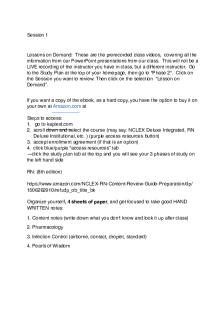Management Accounting (Kaplan 1994) - Summary PDF

| Title | Management Accounting (Kaplan 1994) - Summary |
|---|---|
| Course | Advanced Management Accounting |
| Institution | University of Bath |
| Pages | 2 |
| File Size | 83.6 KB |
| File Type | |
| Total Downloads | 86 |
| Total Views | 134 |
Summary
Summary of a mandatory reading given in class. Summaries are required as the final exam questions will be based on a few chosen mandatory readings. ...
Description
Management Accounting (1984 – 1994): Development of New Practice and Theory Robert S. Kaplan (1994) Introduction -
Revolution in management accounting theory due to failings and obsolescence of existing cost and performance measurement systems
Activity-based Costing Management Rationale -
Improving measurement of manufacturing costs More accurate cost information could influence decisions made by product engineers o 80-90% of manufacturing costs are determined then - Assigning marketing, selling and distribution costs to customers, business segments and distribution channels o Organizational costs throughout a company’s value chain could be accurately assigned to their underlying causes (products, customers, channels and organizational units) Costing field shifted from arguments about how to allocate costs, to identifying the cost flows from organizational spending to supply resources that create the capability to perform Breakthrough for ABC came from two theoretical developments elevating the approach from deductive assertions to scientifically testable hypotheses o Discovery of the cost hierarchy of indirect and support expenses o Distinction between costs of resources supplied and costs of resources used (i.e. role for unused capacity costs) Cost Hierarchy: Unit, Batch, Product and Customer-Sustaining Activities -
-
-
-
ABC cost taxonomy enabled all organizational expenses to be mapped to a particular hierarchical or organizational level where cause and effect could be established o Provided a much richer set of drivers of cost variability, rather than considered variable only with respect to the physical quantities of products and services ABC cost hierarchy provided a powerful connection to contemporary developments in operations management. (i.e. costs only visible if ABC system implemented for explicitly measuring the costs of batch and product-sustaining activities) o Production of high-volume products separated from low-volume products o Utilization of information-intense production technologies to reduce cost of performing batch & product-sustaining activities while retaining efficiencies of high-speed automated production ABC cost hierarchy also connected to the continuous improvement and lean production activities o Reducing set-up times o Improving plant layout based on efficient material flows o Having suppliers deliver components directly to production processes (JIT) Traditional costing systems encouraged managers to spend heavily to reduce their unit-level costs o Produced enormous escalation in batch and product-level expenses
Measuring the Costs of Resource Usage: The Role of Unused Capacity -
ABC measure the costs of using resources, not the cost of supplying resources
-
What makes a resource cost “variable” in a downward direction is not inherent in the nature of the resource; it is a function of management decisions o First to reduce the demands for the resource o Second to lower the spending on the resource
Process of Conceptual Development -
Conceptual advances occurred well after the initial discovery of ABC systems in practice o Studying and teaching cases describing early ABC implementations o Working closely with companies that were implementing ABC systems
Conclusion In an environment of rapid obsolescence, innovation and change, requires scholars who are actively involved in the new practice, alternating among careful observation and documentation, theory development, and intervention and participation in organizational change processes o Learn from teaching experiences and reactions to published writings, then to return to practice to implement the ideas and learn where new conceptual developments are required...
Similar Free PDFs

kaplan Review Summary-endocrine
- 4 Pages

Kaplan NCLEX Summary Recap
- 12 Pages

Kaplan Pharmacology A kaplan
- 6 Pages

Management accounting
- 4 Pages

Management accounting
- 76 Pages

Management Accounting
- 11 Pages

Management Accounting
- 22 Pages

Management accounting
- 4 Pages

solution manual management accounting
- 895 Pages

Chap 2 - Management Accounting
- 13 Pages

ACB2220 Management accounting
- 18 Pages
Popular Institutions
- Tinajero National High School - Annex
- Politeknik Caltex Riau
- Yokohama City University
- SGT University
- University of Al-Qadisiyah
- Divine Word College of Vigan
- Techniek College Rotterdam
- Universidade de Santiago
- Universiti Teknologi MARA Cawangan Johor Kampus Pasir Gudang
- Poltekkes Kemenkes Yogyakarta
- Baguio City National High School
- Colegio san marcos
- preparatoria uno
- Centro de Bachillerato Tecnológico Industrial y de Servicios No. 107
- Dalian Maritime University
- Quang Trung Secondary School
- Colegio Tecnológico en Informática
- Corporación Regional de Educación Superior
- Grupo CEDVA
- Dar Al Uloom University
- Centro de Estudios Preuniversitarios de la Universidad Nacional de Ingeniería
- 上智大学
- Aakash International School, Nuna Majara
- San Felipe Neri Catholic School
- Kang Chiao International School - New Taipei City
- Misamis Occidental National High School
- Institución Educativa Escuela Normal Juan Ladrilleros
- Kolehiyo ng Pantukan
- Batanes State College
- Instituto Continental
- Sekolah Menengah Kejuruan Kesehatan Kaltara (Tarakan)
- Colegio de La Inmaculada Concepcion - Cebu




